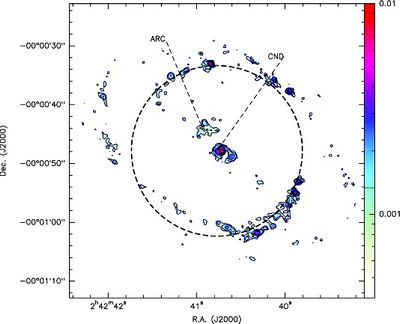Since the late 1970s, only three types of molecules have been found to form megamasers: water, hydroxyl and formaldehyde. In a recent work, Prof. Junzhi Wang from Shanghai Astronomical Observatory (SHAO), together with his colleagues Prof. Yu Gao, Drs. Zhi-Yu Zhang (currently in UK) and Min Fang at Purple Mountain Observatory (PMO), detected both SiO and CH3OH mega-masers near the center of Serfert 2 galaxy NGC 1068 using the IRAM 30m telescope. The work was published in the online only journal, 'Nature Communications' on 11th of November 2014 at 16:00 London time.
A few days before publication, the Nature Publishing Group (NPG) press office distributes a press release about upcoming Nature Communications papers. Within this release, a few papers of particular newsworthiness are highlighted along with author contact details. All authors on these papers are also referenced geographically. The work of Prof. Wang, "SiO and CH3OH mega-masers in NGC 1068”, has been selected for highlighting.
In astronomy, Maser (Microwave Amplification by Stimulated Emission of Radiation) describes a bright object that produces amplified electromagnetic waves. Mega-masers are masers in galaxies that are a million times more luminous than typical galactic maser sources. They are usually associated with active galactic nuclei (AGN), which are bright, compact areas at the center of galaxies. AGN are the brightest objects in the Universe, whose radiation is thought to be from the central black hole accretion. High-resolution observations of megamasers enable researchers to probe the physical properties of their parent galaxies, such as estimates of the central supermassive black hole masses.
Junzhi Wang and colleagues report the detection of both silicone monoxide and methanol (SiO and CH3OH) megamasers near the center of the Seyfert 2 galaxy, NGC1068, using the IRAM 30-meter telescope. “Based on our observations, we suggest that the SiO megamaser originated from a dust disk at the center of the galaxy and that the CH3OH megamaser originated at the front of a shock wave. Besides these preliminary observations, further confirmations are still required before information about host galaxies can be inferred.” Prof. Junzhi Wang said. Prof. Wang did his postdoctoral work between 2005-2007 in Prof. Yu Gao’s research group at PMO.
The co-authors of this paper are Prof. Jiangshui Zhang of Guangzhou University, Prof. Yu Gao of Purple Mountain Observatory, Dr. Zhi-Yu Zhang (completed his PhD thesis at PMO last year under supervision of Prof. Yu Gao) from University of Edinburgh (UK), Prof. Di Li from National Astronomical Observatory of China, Dr. Min Fang of PMO, and Prof. Yong Shi from Nanjing University. This work is based on observations carried out with the IRAM 30m Telescope. IRAMis supported by INSU/CNRS (France), MPG (Germany) and IGN (Spain). Funding is partly supported by 973, NSFC and CAS pilot-b.

By with for GAO Yu
ALMA 349 GHz dust emission. Data were provided by Dr. Santiago
Link to the NPG press news: http://dx.doi.org/10.1038/ncomms6449




